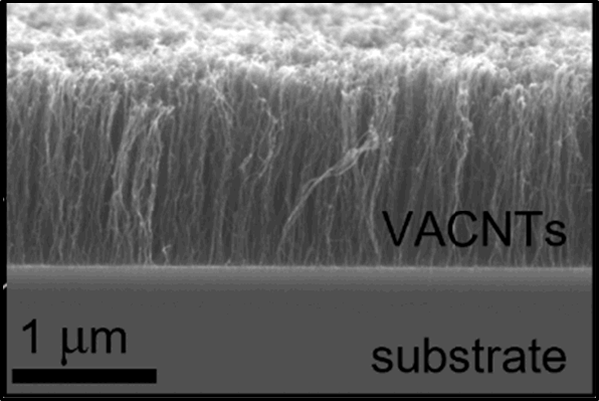Materials capable of modulating the propagation or emission of light from surfaces, both in the visible and infrared, are of interest for displays (televisions, tablets, billboards), optical telecommunications, and radiative thermal management in residential, industrial, and commercial buildings. Previous research demonstrated the effects of electrical bias or electrolytic gating on the absorption/transmission/emission of infrared radiation with carbon nanotube-based devices. These prior demonstrations often use mats/sheets consisting of randomly-oriented, typically flat-lying carbon nanotubes (CNTs), which is disadvantageous since poor control of the orientation leads to poor control over the optical response of the device.
LLNL inventors have developed an electrochromic device containing Vertically Aligned single walled CNTs (VACNTs) with a range of diameters. The assembly of these devices into electrochromic windows filled with ionic liquid allows for reversible modulation of the Fermi level in the VACNT film. These electrochromic devices show strong voltage-dependent transmission of near-infrared radiation. They can potentially be fabricated into large-area windows which modulate the flow of infrared heat into buildings among other applications.
Image Caption: Cross-section SEM image of an as-made VACNT forest on Si
Carbon nanotube ‘smart windows’ offer energy savings
Alex Abelson, Philip M. Jean-Remy, Tom Nakotte, Paul E. Munger, Steven F. Buchsbaum, Sei Jin Park, and Anna M. Hiszpanski, Exploiting Intersubband Plasmons in Vertically Aligned Carbon Nanotubes for Near-Infrared Electrochromic Windows,
Nano Letters 2025 25 (31), 11762-11767
- The demonstrated, non-optimized electrochromic performance showing a maximum change in transmittance at ~1.7 micrometers IR wavelength of 47%.
- Potential to use VACNT actuation as on/off switch to control transmittance and emission of IR radiation.
- Controlling the transmission of light within this optical IR wavelength band is ideal for dynamic windows that regulate the temperature inside of buildings.
Smart glass and smart windows
Current stage of technology development: TRL-3
LLNL has filed for patent protection on this invention.


